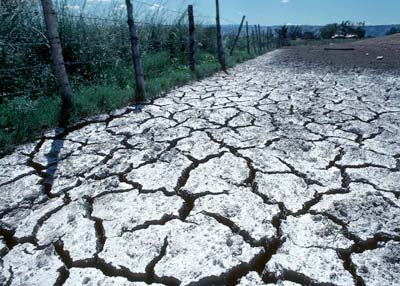The term soil salinity refers to the amount of soluble salts in a soil.
Salts are a natural part of soils, but at elevated levels can negatively affect plant growth and soil structure. Some soils become saline through natural processes, especially when they form on parent materials rich in carbonates and sulfate minerals and in arid and semiarid regions. In such soils, rainfall may be insufficient to leach salts out of the soil profile. In other areas, salinity may result from high evapotranspiration and ground water recharge, with aquifers carrying dissolved salts from a source that may be several kilometers away. Salinity is not usually a problem in humid areas with the following exceptions: (i) soils affected by an intrusion of seawater and (ii) near a high concentration of a fertilizer material with a high salt index. Anthropogenic activities such as irrigation with saline water and application of salt to roads can also increase soil salinity. In 2001, about 12% of the land area in the agricultural regions of the Prairies (8 million ha) was rated as having a moderate, high or very high risk of salinization (for more information you can visit the Agriculture and Agri-Food Canada website).
Salinity issues are a challenge for landowners and resource professionals in semi-arid and arid regions around the world such as the Colorado River Basin.
Salt buildup on the soil surface caused by salt-laden water percolating to the surface and evaporating.
The diagnosis, assessment, management, and need for reclamation of saline soils and the suitability of waters for various purposes, including irrigation, are evaluated using information of soil and water salinity. The reduction of plant growth due to high salt content in the soil is related in part to osmotic effects and also to the specific ions involved (Na+, Mg2+, Ca2+, K+, Cl-, SO42-, HCO3-, and CO32-). Salts are electrolytes, therefore, a high concentration of dissolved salts is associated with a high electrical conductivity of the soil solution. There are a variety of methods to measure salinity, both in the field with electrode sensors and in the laboratory.
References & Resources
- Agriculture and Agri-Food Canada. No date. Soil Salinity. Available at: http://www5.agr.gc.ca/resources/prod/doc/env/naharp-pnarsa/pdf/chap15_e.pdf [Accessed 4 May 2017].
- Bresler, E., B.L. McNeal, and D.L. Carter. 1982. Saline and Sodic Soils: principles, dynamics, modeling. Springer-Verlag, New York.
- Manitoba Agriculture, Food and Rural Initiatives. Soil Management Guide, soil salinity. Available at: http://www.gov.mb.ca/agriculture/environment/soil-management/soil-management-guide/pubs/soil-management-guide.pdf [Accessed 4 May 2017]. (Non-pdf webpage: Soil Salinity)
- Rhoades, J.D. 1996. Salinity: electrical conductivity and total dissolved solids. In Sparks, D.L. (ed). Methods of Soil Analysis: chemical methods. Part 3. Soil Sci. Soc. Am. Book Series No. 5. ASA-SSSA, Madison, WI.
- United States Salinity Laboratory Staff. 1954. Diagnosis and Improvement of Saline and Alkali Soils. Agriculture Handbook No. 60. U.S. Department of Agriculture. Available at: http://www.ars.usda.gov/Services/docs.htm?docid=10158&page=1

